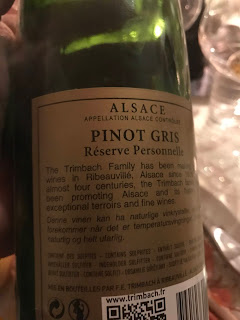Rioja Blanco Gran Reserva 2012, Hacienda Lopez de Haro
Gul, krydder, curry, steinaktig, i en utviklet stil med lav syre. Mandarin, rik nese, en litt rar vin og vi var i Portugal eller Spania. Kim var i Rhone. 87 poeng
Dn; Dufter av voks og nøtter med hint av lær. Moden og krydret frukt på smak med en balansert syre og en lang og fyldig utgang. Kr. 269,-. 86 poeng
Puligny Montrachet Les Pucelles 2011, Domaine Leflaive
Blank transparent, grønn med frisk syre. Lite utviklet, relativ enkel i munnen og en vanskelig vin å vurdere. Stilkete, ung vin, stram, Aligotè ? Knut var tidlig på Chardonnay ! Lite utviklet for en 9 år gammel vin. Thight og en gjerring Leflaive. Vil den utvikle seg positivt eller er det bare en vanskelig årgang ? 90 poeng
Denne beskrivelsen fra Cellartracker passet ganske godt: The nose is initially bright green and yellow apple and mild citrus. Slight reduction, but not the Leflaive grand cru caliber gunpowder. Quite mineral and slightly saline in a youthful phase. Candied lemon bits. The palate is missing concentration and weight, and has thin yellow apple fruit. The acid is quite nice, but the fruit is a real let down. This is assisted by air, and the nose is interesting, but the palate never picks up any staying power on the back end. Slightly longer and more dense after 90-minutes. I am consistently disappointed with the Leflaive premier crus, but always love Batard, BBM, and Chevalier. 90
Gylden, moden, rik og relativt fet i munnen. I munnen senhøstet riesling med rulletobakk og en fin balansert syre. Lars Ivar var raskt på riktig vin. En av de bedre Coulèe dS Vinklubben har hatt og dette er vel før botrytis tok over smaksprofilen til hans viner. Hele 91 poeng faktisk.
From bowlerwine.com:
Coulée de Serrant has a long and proud history. Once a monastic vineyard- parts of the estate have been under vine for almost 900 consecutive vintages to date- it lies completely within the boundaries of Savennières, and is actually one of the few estates in France that is also its own appellation.
Nicolas Joly had a successful career in finance when he took over his family’s estate in the Loire in 1977. “They told me that my mother had been running the estate well, but in an old fashioned way, and it was now time for some modernity. I was told that if I started using weed killers, I’d save 14,000 Francs.” He took this advice, but regretted it almost immediately; the biodiversity in his vineyards plummeted. Even the soil seemed to die. Joly wasn’t a follower of the green movement when he picked up a book on biodynamics; he was simply trying to find a better way to manage his vineyards. Since then, he has become one of the great authorities in the field, and his holdings have been farmed using biodynamic principles since 1984.
Nicolas now manages the winery with his daughter, Virginie. Following biodynamic principles, the Joly's use compost from their own herd of cows, donkeys, horses, and goats. To limit the negative effects of monoculture, more than a dozen different native plants are found throughout the vineyards, allowing each root to develop different micro-organisms. Sheep feed on the cover crop and leave manure. In the spring, a chicken coop is set up in the areas with snails. Biodynamic preparations are made from medicinal plants (mostly from the winery property) including: sage, sorrel, willow, nettle, elm, oak bar, arnica, and blackthorn. Horses are used to plow between the rows, and of course, no pesticides come anywhere near these pristine vineyards. Grapes are harvested late, so that the wines gain in complexity. In the opinion of the Joly family, Chenin achieves complexity only when it is fully ripe. To harvest the most perfectly ripe berries, harvesting is done in several passes. In the winery, the process is as natural and hands-off as possible. There is no chaptilization, only indigenous yeasts are employed, there is no settling of the grape must, and natural temperature variation is allowed during fermentation. Because fermentations take place naturally, they may last 2 to 4 months or more. While this is a terrifying prospect to most winemakers, it is simply how things are done at this famed estate.

Domaine de Chevalier Blanc 2003, Pessac Leognan
Blomster, eple, ullsokk, svovel med noe røykpreg. Lang finish med et litt overmodent preg. Som passer godt til den varme årgangen. Litt reduktiv og lukket. Noen var på Roulot, mens andre var på hvit Bordeaux. Vellykket vin i en vanskelig årgang for hvitvin. 92 poeng
Bruspulver. litchi, hyllebær og vi var vel relativt raskt på Pinot Gris. Selv om Kim hang noe igjen på Gewûrz. Utviklet varm nese, moste jordbær. God vin til prisen (2015 VP kr. 375,-) 89 poeng







Ingen kommentarer:
Legg inn en kommentar